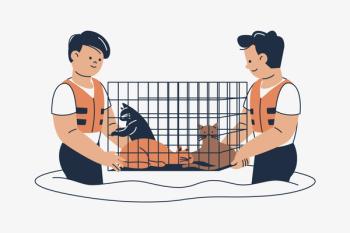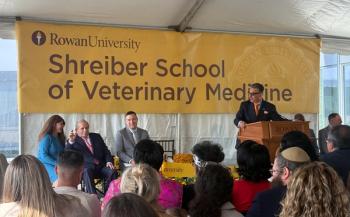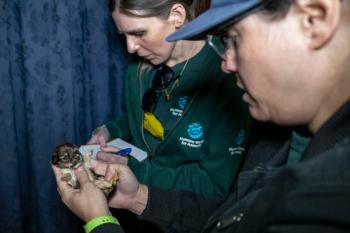
Animal-welfare concerns are changing the way DVMs work
New animal-welfare laws are at a high and it's taking its toll on the profession.
National Report — Animal-welfare issues are becoming more prevalent, as evidenced by the sheer volume of legislation introduced and adopted throughout the country recently.
In 2008, states enacted nearly 40 laws pertaining to animal welfare, and another 33 were introduced.
So far this year, nearly a dozen such laws have been making the rounds in state legislatures.
In addition to government involvement, more veterinarians are taking stands against performing cosmetic and convenience surgeries.
There is increasing veterinary support for changes to long-standing agricultural practices, too, as evidenced by the 700-plus California veterinarians who endorsed Issue 2, the prevention of farm-animal cruelty act, last year.
The shift can be seen within the American Veterinary Medical Association (AVMVA) as well.
That's one reason why the AVMA now asks, "Why do we do this procedure?" as opposed to "What are the harms associated with this procedure?" says Gail C. Golab, PhD, DVM, MACVSc, director of the AVMA Animal Welfare Division.
"Asking the first question is likely to result in a closer look at the origins and bases of traditional animal care practices," Golab says.
Both external and internal issues are leading the change, including public demand. And the focus of welfare continues to evolve with an increased interest in looking more closely at animals' mental needs, as well as more of interest in the well-being of fish and invertebrates.
Veterinary colleges are taking notice of these changes in animal-welfare conciousness, too, and have put more teaching emphasis on humane techniques.
"The field is changing," says Dr. Marguerite Pappaioanou, executive director of the Association of American Veterinary Medical Colleges (AAVMC). Societal attitudes and the fact that people are farther removed from the farm and just more aware of these issues is driving it. "I think it's a positive thing."
Veterinary graduates also are changing. While DVMs who graduated 20 or 30 years ago may have to adapt to some of these welfare changes, graduates just coming out of school have been acclimated to them throughout their lives.
Thirty years ago, the big focus was on animal research. Over the years, that has evolved. Use of anesthetics and pain management, shelter care, feral-animal issues and now a growing attention on how food animals are produced are at the forefront.
The formation of the Humane Society Veterinary Medical Association (HSVMA) further shows an increasing interest in animal-welfare issues, says Barbara Hodges, DVM, MBA and veterinary consultant for the HSVMA.
"Welfare may have been seen as a specialty interest in the past, but we as veterinarians must be concerned primarily with our patients' health, and industry concerns should not trump the welfare of our patients," Hodges says.
Welfare in academia
Veterinary students are entering school with those ideas as a result of changes that have elevated the status of animals.
As a result, humane veterinary training will continue to be an area of rapid change, Hodges says.
"We're migrating toward a position where no animals are going to be killed in the training process," she says. "Newer veterinary students and practitioners are refusing to do these procedures. In large part, students themselves have helped make these changes occur."
And it's important for colleges to make sure new graduates are well-grounded in animal welfare, especially with topics such as ear cropping, says Pappaioanou.
"We should be leaders in this area," Pappaionanou says.
Small animals, big issues
Companion-animal practitioners have seen their share of welfare challenges in recent years as well. Ear cropping, tail docking and declawing most frequently are discussed.
Many practices no longer offer ear cropping, if they ever did, and some do not perform tail dockings.
Dr. Erinn Kelly, of Lincoln Park Veterinary Hospital in Lincoln Park, Mich., has practiced for 18 years and has never performed an ear cropping, although her clinic did offer them until six years ago.
"We didn't feel they were humane," she says of the decision.
If someone requests the procedure, they refer the client to another veterinarian in town.
Overall, Kelly says requests for ear cropping and tail docking seem to be on the decline.
She has noticed an uptake in the number of laser declaws and use of pain medication.
"Pain control for elective procedures is a lot more accepted," she says. "In the past, we never offered it for spays or neuters. Now, if it's offered, 95 percent of the time they accept it."
While some activists have made an issue of declawing, Kelly does not have a problem with it.
"If it keeps the cat in the home, it's not an ethical issue for me," she says. "I have three cats of my own, and they're declawed. I do strongly encourage doing it at an early age, and I strongly encourage laser declaw."
Welfare of food animals
Not only has the AVMA strengthened its stance on ear cropping and tail docking for dogs, it also has taken positions on veal crates and gestational crates for sows.
And more veterinarians will take a stand against inhumane farm-animal practices, Hodges predicts.
"Confining sows to gestation crates, the forced feeding of ducks and geese to produce foie gras, as the demand increases for more humanely sourced food products, so will our role in advocating for them," she says.
The animal-welfare issues are good points, says Dr. Keith Schumacher of Nebraska Veterinary Services in Howells, Neb., but aren't easy to implement.
In many instances, well-intentioned welfare issues mean taking a step back when it comes to food quality, he says, adding that the biggest challenge isn't getting food producers to adhere to the changes, but educating them as to why they need to be made.
"Most already are pretty good about taking care of their animals," Shumacher, a mixed-animal practitioner, says. "It's their livelihood."
With 23 years in practice, Shumacher has seen a major change in attitude regarding the way people view food animals.
"The public is way more aware of it because of animal-rights and animal-welfare issues," he says.
With anything, there are bad cases, but there also are good cases," Shumacher points out.
"The public doesn't see it because the vast majority of them did not grow up in a rural setting." He points to using gestation crates for swine.
"If we go back to the other way, it's not as efficient, not as productive and we're not able to take as good care of the animals," Shumacher says.
"There are reasons animals are housed the way they are.
"And with some of these issues, we're probably taking a step back in food quality, but a lot of people don't care."
Leaders speak out
"Animal welfare has been more divisive in the profession than it should be. It is my hope that, going forward, more veterinarians embrace it. I believe they will, considering that most now entering the profession have well-developed sensibilities in this area."
— WAYNE PACELLE, PRESIDENT AND CEO, HUMANE SOCIETY OF THE UNITED STATES
Newsletter
From exam room tips to practice management insights, get trusted veterinary news delivered straight to your inbox—subscribe to dvm360.






